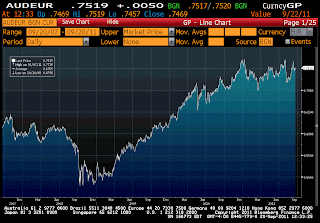I am going to hop on (get it?) an
ongoing debate started by Jeff at Beervana (in fact he egged me on to do so) by talking about beer arbitrage. It all started with a link to
this article in the
Washington Post. [You should go and read Jeff's post and the very interesting and informed discussion that followed in the comments]
While it focuses mostly on the eBay marketplace for beer (which is both prohibited by eBay and, if sold across state lines, most likely the law), I want to focus on the bigger picture: the secondary beer market itself.
The fact that these market have arisen suggests that there was a missing market problem: buyers and sellers who would like to transact but for whom there is no forum for such transactions. The most common reason for such transactions is some sort of regulatory constraint. Black markets in command and control economies like the former Soviet Union are a perfect example: shoes are on sale in Moscow, but there is little demand, so buyers buy them and sell them illegally in Siberia and so forth.
In this case I suspect the main culprit is interstate restrictions on the sale of alcohol and the fact that a lot of the special beer can only be obtained close to the brewery. So this secondary market is really about circumventing the law - making money by breaking it. But it is also about beer lovers who are willing to pay a lot to get some special beers that they crave and I agree entirely with Jeff, I fail to see how the resale market in any way exploits brewers. The very existence of such markets means that additional value from the production and consumption of the beer is being created. Which is good.
For the sake of argument let's forget about the regulatory constraint and suppose I decide to sell the bottle of Roots Epic that I have in my basement to a local buyer. I am pretty sure I could get more for it now than when I bought it. I have a willingness-to-sell price above which the cash is worth more to me than the beer. I suspect there is someone out there with a willingness-to-pay price above my sell price and below which the beer is worth more than the cash. If we can agree on a price somewhere in between my price and his/her price we are BOTH better off going through with the transaction. This is precisely the entire point of markets: they create value by facilitating mutually beneficial exchanges. Why this should be frowned upon is completely beyond me.
Here is a snippet from the article:
“In another life, I would be a consumer advocate,” Stone’s Koch says, adding that high prices also are problematic because they often accompany second-tier products. Some beers, such as hoppy India pale ales, quickly lose their vibrancy or go rancid when exposed to light and heat. “Frankly, somebody’s naive if they pay big dollars for this stuff on eBay,” Koch says. “They think they get a rare, special beer, but the reality is that they get a rare beer but it’s no longer special.”
Ultimately, though, what seems to upset brewers most is their sense that they are being exploited. “You want to hear about the framboise story?” said Russian River’s Cilurzo. “I am furious about this.”
Last September, Russian River released Framboise for a Cure, a raspberry-flavored beer that it sold for $12 per bottle to raise money for a local breast cancer treatment center. The beer sold out in a day, and soon somebody sold a bottle on eBay for $400. Then someone else put one up for sale. “We contacted that person,” Cilurzo says, “and we said, ‘This is absolutely ridiculous, because we donated 100 percent of this for charity.’”
But this is ridiculous, there is nothing pro-consumer about special releases and events that restrict the beer to a lucky/well-connected/eager set of consumers. What this secondary market is telling you is that you are excluding lots of your consumers and doing so in an inefficient way. And if Russian River wanted to raise money for the Cure, they should have raised the price of the beer, because they probably could have sold it for more. But they got the $12 they wanted for charity, I fail to see how the resale of the bottle has anything to do w.th it, it is not going to affect the amount raised.
Furthermore, the implication that buyers of high priced Vertical Epic bottles are getting a degraded product is totally beside the point. Any buyer paying that much surely knows enough about beer to know the risk he/she is taking. And who are we to judge their preferences. I would not spend the money, but that is me, everyone else can follow their bliss.
So in the end, I do not think secondary markets are evil, just the opposite. In general I love to find little instances where markets arise spontaneously due to some missing market problem and this is but another case.















